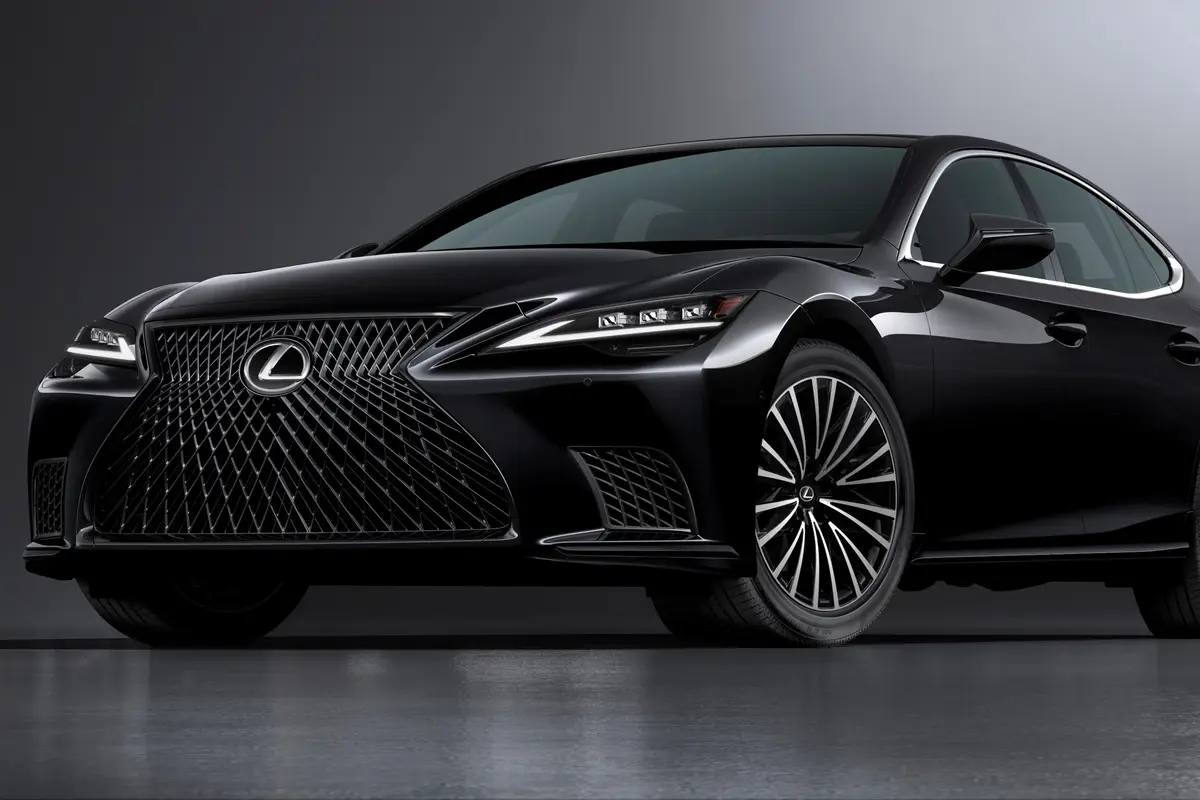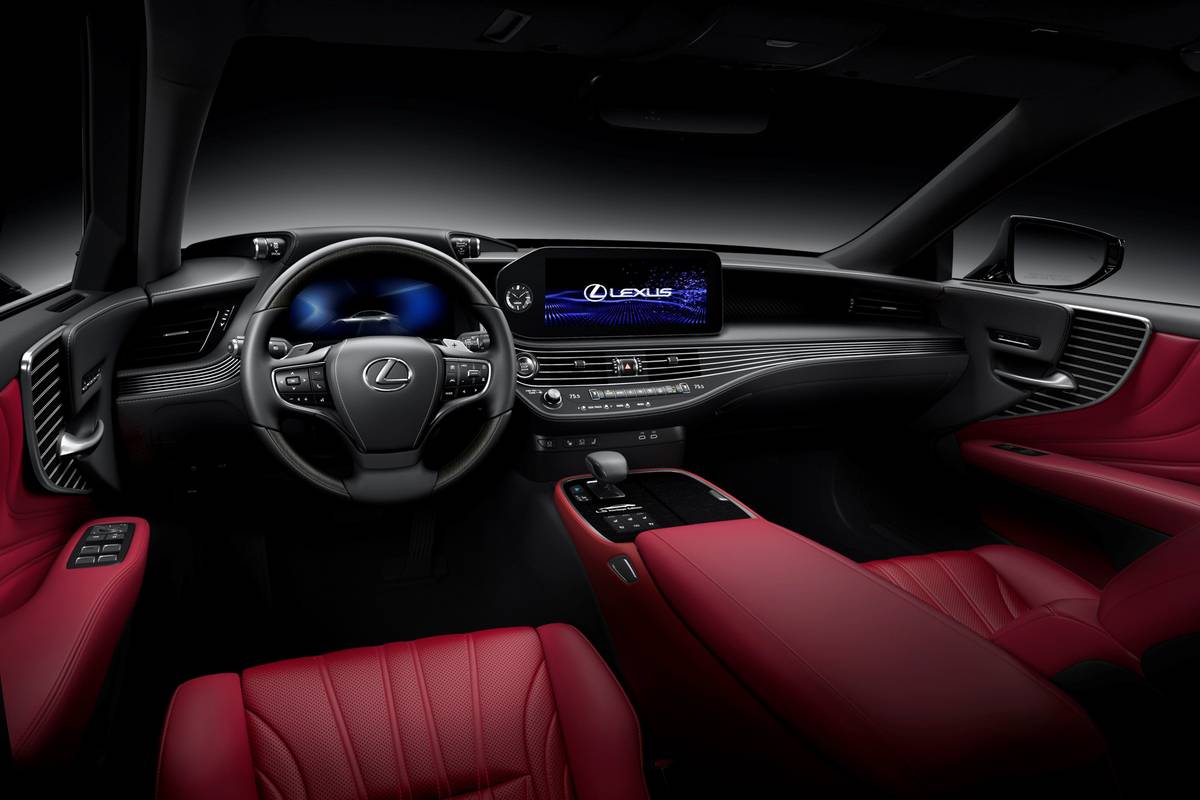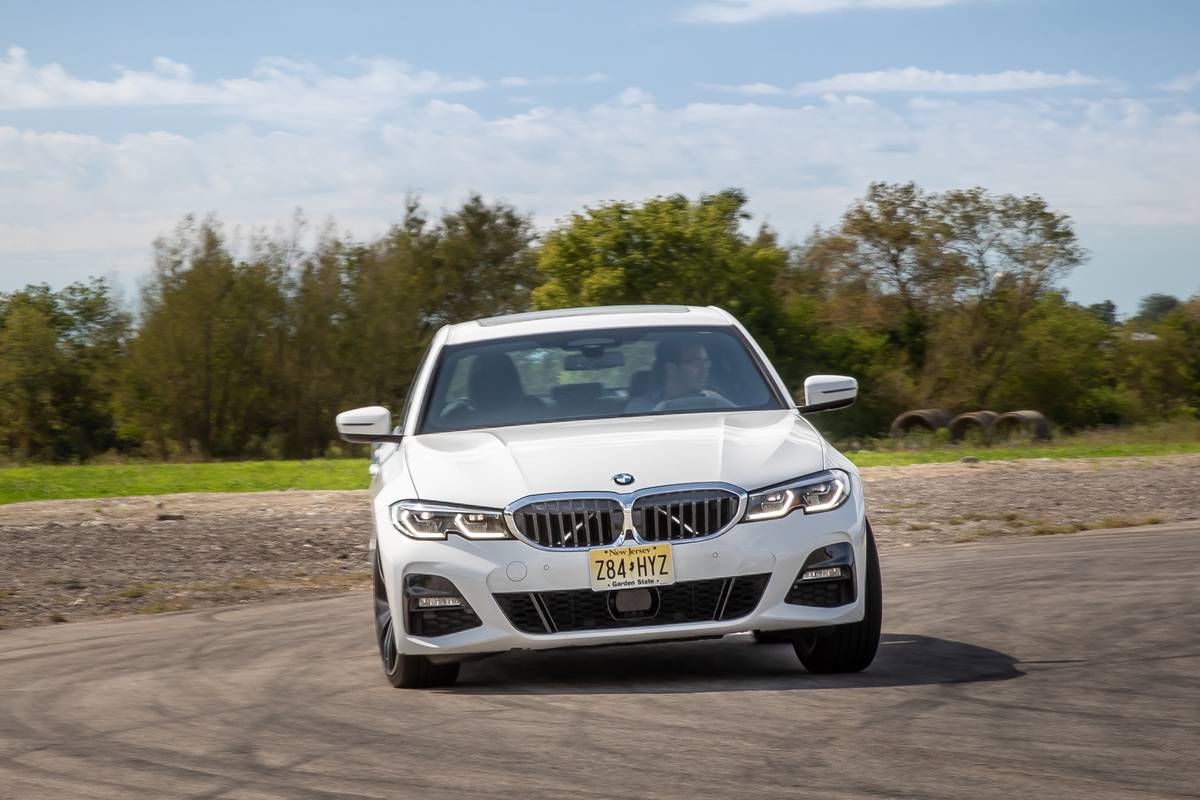2026 Lexus LS 500 Takes Last Spin With Special AWD Heritage Edition
Key Points:
- The 2026 Lexus LS 500 AWD Heritage Edition marks the end of the full-size sedan after a 36-year run.
- The LS Heritage Edition costs $99,280 (including a $1,450 destination charge) and will be limited to 250 models.
- The 2026 LS 500 Heritage Edition goes on sale this fall.
Pour one out for another discontinued sedan: This time, it’s the Lexus LS 500 full-size luxury sedan. Lexus honors its erstwhile flagship with one last model, the limited-edition 2026 LS 500 AWD Heritage Edition. The tribute celebrates the end of a 36-year run in the U.S. and will be limited to 250 units at a price of $99,280 (including a $1,450 destination charge).

2026 Lexus LS 500 AWD Heritage Edition | Manufacturer image
What Does the Heritage Edition Come With?
The Heritage Edition is the only trim level available for the 2026 LS 500. It comes in an exclusive black paint that Lexus calls Ninety Noir and has 20-inch 20-spoke alloy wheels in a dark gray color that looks, well, black. It’s contrasted inside with red semi-aniline leather upholstery called Rioja Red, and no special edition is complete without all the badging.

2026 Lexus LS 500 AWD Heritage Edition | Manufacturer image
Lexus loads the Heritage Edition with all the safety and convenience features. It comes with Lexus Safety System+ 3.0, which includes forward collision warning with pedestrian detection, automatic emergency braking, adaptive cruise control, lane departure alert and steering assist, lane-centering steering, road-sign recognition and automatic high beams.
Standard tech and convenience features include a 12.3-inch digital gauge cluster, 12.3-inch touchscreen with wireless Apple CarPlay and Android Auto connectivity, wireless phone charger, six USB ports, a 360-degree camera, Digital Key and a 10-inch head-up display. Creature comforts include power heated and ventilated front seats with massage, heated rear seats, a 23-speaker Mark Levinson sound system, active noise cancellation and a heated steering wheel with wood trim.
Powertrain Specs and MPG
For 2026, Lexus has ditched the hybrid powertrain offered in the 2025 LS, leaving only the twin-turbocharged 3.4-liter V-6 engine in the Heritage Edition; it makes a robust 416 horsepower and 442 pounds-feet of torque. A 10-speed automatic transmission drives power to the all-wheel-drive system, and a Torsen limited-slip rear differential aids with traction. The 2026 LS has a 0-60 mph time of 4.6 seconds, and Lexus expects the EPA to certify it at the same 17/27/21 mpg city/highway/combined as the 2025 model (official EPA ratings for 2026 are not yet available).
Read More About the Lexus LS 500:
- The 2022 Lexus LS 500h Has a Hands-Free Driving System; We Try It
- Study: Most Automaker Partial Automation Driving Systems Need Improvements
- How Do Car Seats Fit in a 2019 Lexus LS 500?
- Research the Lexus LS 500
- Find Your Next Car
Related Video:https://players.brightcove.net/1578086878/HyOJ1bP6_default/index.html?videoId=6355365048112
Cars.com’s Editorial department is your source for automotive news and reviews. In line with Cars.com’s long-standing ethics policy, editors and reviewers don’t accept gifts or free trips from automakers. The Editorial department is independent of Cars.com’s advertising, sales and sponsored content departments.
196,000-Plus BMWs, Toyota Supras Recalled for Fire Risk

By Corinne Vercoe
September 26, 2025
Share 2019 BMW 330i | Cars.com photo by Christian Lantry
2019 BMW 330i | Cars.com photo by Christian Lantry
BMW is recalling more than 196,300 vehicles, including examples of the Toyota Supra, which was co-developed with the German automaker and shares a powertrain, chassis components and interior bits with the latter’s Z4 roadster.
Related: More Recall News
In addition to the model-year 2020-22 Supra, affected BMWs include the following models and model years:
- 2019-21 330i sedan
- 2019-22 Z4 roadster
- 2020-22 530i sedan, X3 and X4 SUVs
- 2021-22 430i sedan
- 2022 230i coupe
The engine starter relay in these vehicles may corrode, causing it to overheat and short-circuit, increasing the risk of a fire.
Dealers will replace the engine starter for free, but until the remedy is performed, owners are advised to park outside and away from structures. Interim letters notifying owners of the issue are expected to be mailed Nov. 14; a second letter will be sent out once repair parts become available. Those with further questions can contact BMW at 800-525-7417, the National Highway Traffic Safety Administration’s vehicle-safety hotline at 888-327-4236, or visit its website to check your vehicle identification number and learn more.
More From Cars.com:
- Recall Basics: Everything You Need to Know
- My Car Is Recalled, But There’s No Fix Yet: What Do I Do?
- Why Can Dealers Sell Used Cars With Unfixed Recalls?
- More BMW News
- More Toyota News
Related Video:https://players.brightcove.net/1578086878/HyOJ1bP6_default/index.html?videoId=5134011854001
Cars.com’s Editorial department is your source for automotive news and reviews. In line with Cars.com’s long-standing ethics policy, editors and reviewers don’t accept gifts or free trips from automakers. The Editorial department is independent of Cars.com’s advertising, sales and sponsored content departments.
First Drive: The Polestar 5 Isn’t Just A Porsche Taycan Fighter. It’s Even More Interesting
Polestar’s new 884-horsepower super-sedan isn’t what I expected it to be. Instead, it’s something that truly raises the bar.
![]()
Photo by: Patrick George
By: Patrick George
Sep 8, at 2:00pm ET
Share
21
Comments
Chris Baguley wanted to go out again. He didn’t insist on it, per se, but the rain had tapered off a while ago and the tarmac at the Millbrook Proving Ground was finally drying off. I was impressed enough with the Polestar 5 in the wet, but now the car’s chief engineer wanted me to experience it in the dry.
Who was I to say no? When a top engineer, who’s also a superb wheelman in his own right, wants to show you what his 884-horsepower electric grand tourer could do on a proper track, you shut up and get in the passenger’s seat.
We had another go, and once again, I got tunnel vision from the acceleration the Polestar 5 could put down. And when Baguely completed our lap, he flashed a big grin, as if to say: “Not bad, right?”He didn’t have to say anything. Lots of EVs are fast, especially in a straight line. But the point Baguely was trying to make came loud and clear: few fast EVs handle quite like the Polestar 5 does. And this thing has what it takes to challenge—I’m not saying beat, but challenge—the almighty Porsche Taycan. And even the likes of the Lucid Air, while it’s at it.
If it comes to the United States, it’ll make for a fascinating match-up. But that remains a fairly ambiguous if.
(Full Disclosure: Polestar flew me to the United Kingdom last month for a preview drive of the Polestar 5. The brand covered my travel expenses.)
Polestar 5: What Is It?
The Polestar 5 makes its world premiere today at IAA Munich, Europe’s largest auto show. It’s being hailed as a big deal for the sometimes-troubled but aspirational electric luxury brand, which was spun out of Volvo and has deep ties to the rest of China’s Geely Group.
To understand why, it helps to go back to the beginning.
The Polestar 1 was a limited-run plug-in hybrid luxury coupe that packed a lot of power but looked like a two-door Volvo S90, because under the skin, it basically was one. Then came the Polestar 2, a much-beloved electric sport sedan and early Tesla Model 3-fighter, but based on the Geely Group CMA platform that underpinned the Volvo XC40 and other cars.
Next was the Polestar 3, which offers excellent performance and style, but is again a twin to another Volvo. And finally, there’s the Polestar 4: Korean-made but also on another shared Geely Group platform used by various Zeekr and Lynk & Co. models, albeit with its own spin on things.
You get the idea. Polestar may be a newer brand, but under the skin, its cars have borrowed heavily from the rest of the family.
The Polestar 5 is where that starts to change. It’s built on an entirely new architecture exclusive to Polestar, including an all-aluminum platform and body, an 800-volt electrical architecture, an internally developed rear motor and plenty of other touches to make it something truly unique.
“The most Polestar Polestar yet,” is how it was described to me. And that sort of thing is going to be key to making Polestar finally stand out from Volvo and the rest.
Polestar 5: Design And Tech
And it does stand out. It’s a low, sleek sedan, angular in the right ways and perhaps echoing designs like the original Audi A7—hardly a bad thing to my eyes. You may remember the Polestar Precept Concept; this is that, taken to production with almost everything except the rear-hinged doors, which present crash-test challenges.
On the inside, it’s roomier than a Taycan, which admittedly isn’t hard to do because that car can feel more like an electric 911 than Porsche will admit. But the amount of rear headroom inside surprised me. My 5 foot, 11-inch frame never felt cramped in it, which can happen in some EV sedans like the Mercedes-Benz EQs, and I’m not even really that tall.
How much you’ll like the interior depends on how much you like Polestar’s signature Scandinavian minimalism. (The same goes for the fact that, like most Polestar models, this one comes in Gray, Silver, The Other, Second Gray, White, Black, and who knows, down the line—Possibly Another Gray.)
Now, let’s get to the obvious: there’s no rear window. But the whole design and process is more artfully done than the Polestar 4 (and as much as I like the Polestar 4, this feels like the car it’s trying to be) and in my limited drive on the track, I can’t say I minded the camera-based rearview mirror much. It all works functionally just fine, though it’s still an acquired taste.
In terms of software, you get Polestar’s standard Android Automotive operating system with Google built-in. While I didn’t get to play with it much on this drive, I’ve largely been impressed with that system’s speed, flexibility and voice recognition before, but more testing will be needed to render a final verdict.
Polestar 5: EV And Platform Specs
The Polestar 5 Performance—the top version and the one I tested—has a 112-kilowatt-hour battery (106 kWh usable) that powers dual motors and puts down the aforementioned 884 hp and 749 lb-ft of torque. You also get MagneRide adaptive dampers, bespoke Michelin performance tires and higher torsional rigidity from the platform than many gas-powered sports cars, Polestar says.
But people don’t buy EVs for track days, or for performance alone. On the electric front, the Polestar 5 seems very competitive. Range for the base Dual Motor car is rated at 670 kilometers (416 miles) on Europe’s WLTP cycle, while the more powerful Performance version can go 565 km, or 351 miles. In EPA estimates for America, that equates to 330 miles for the base car, and 300 for the Performance. The max charging speed is a very healthy 350 kilowatts, and it can charge from 10% to 80% in 22 minutes.
All in all, it’s an impressive package. And making something that wasn’t just another chip off the Geely block was the whole point.
“There’s no group platform on which you can deliver this car,” Pete Allen, the head of Polestar UK’s R&D arm, told me. Nothing the Geely Group offered could make a car this low, or this stiff, or this light, so Polestar went out and made it alone. And the company won’t be watering it down later. “This is a no-compromise platform,” Allen said. “It’s only there to do sports, GT cars. There’s no plan to make an SUV off this platform.”
Allen is British. So is Baguley, the lead dynamics engineer. So were a bunch of other folks who worked on the Polestar 5. The car drives like it was made by a bunch of people who’ve worked at places like Lotus and McLaren, because it was.
I suppose this makes sense. If you want AI in a car that opens your trunk when you ask it to, call up a Chinese automaker. If you want to make a car that is God’s gift to handling, call some Brits.
Polestar 5: Track Tested
For all those aluminum weight savings, the Polestar 5 still comes in at a beefy 5,518 pounds; a battery that size is heavy, and there’s no way around that. Beefier than a Taycan, for sure. But this platform affords an agility that belies its weight. Out on the Millbrook Proving Ground track—where prototype McLarens and Morgans can be seen alongside British military vehicles, hence why only Polestar was allowed to take photos—the Polestar 5 proved itself to be one of the best-handling EVs I’ve ever driven. Maybe even the best, although it’ll take more data to determine that for real.
The sedan’s steering is tight and direct. Porsche has it beaten on feel, but the 5 feels nimbler and smaller than it is. The ride quality still errs on the side of harsh, which could change if it comes to the U.S., but it’s tight and direct and handles a two-mile high-speed bank with as much confidence as it does a set of winding, off-camber blind curves. Baguley made better work of it than I could, but even a semi-skilled track driver like myself could get a lot out of it, and then some.
It’s not just a handler, either. It’s fast. Crushingly so. I did two hard launches on a straight and managed a zero to 60 mph run in 2.7 seconds, in the wet, which is considerably better than Polestar’s quoted 3.1-second time. And every launch kind of sucked the blood back in my eyes, warping my sense of reality a bit. Even by EV standards, it’s a beast. I managed to get it up to 155 mph on Millbrook’s back straight, tying it with a Cadillac CTS-V at Circuit of the Americas for the fastest I’ve driven any car on any road.
Above all, the Polestar 5’s notable for the analog vibe it has. There are surprisingly few hold-my-hand gizmos for a high-tech EV grand tourer. It doesn’t have active anti-roll-bars, or torque vectoring or an air suspension—all conscious choices, the engineers said, to make something that felt approachable and rewarding to driving enthusiasts.
Polestar 5: Early Verdict
But as much as I liked this thing, even I’ll admit it’s a tricky sell. Polestar could use some wins lately, and what the Polestar 5 is—an expensive halo car—can’t make that happen alone. It’s targeting Porsche with a lot of the performance capability, but almost none of the brand cachet.
The prices reflect its ambition. The base Dual Motor Polestar 5 will start at 119,900 Euro, or about $140,000, while the Polestar 5 Performance I tested is 142,900 Euro, or $167,000 at current exchange rates. That’s not what it would cost stateside—exchange rates, tax differences and tariffs mean you can’t simply convert one price to another—but it won’t be cheap.
Then there’s the fact that I’m left wondering if it can come here at all: It’s made in China, at a new sustainability-focused plant in Chongqing. Engineers said it’s borderline impossible to move the tooling for such a bespoke platform to another location, so if it’s to come to America, it would face an additional 100% tariff.
“As with previous vehicles, we are taking a staggered approach to the launch,” a Polestar official told me. “The initial launch locations for Polestar 5 will include 24 of our 28 active markets and availability for customers in the U.S. will be announced at a later date.”
Gallery: 2026 Polestar 5
75
Source: Polestar
I’ll take that as a maybe. But I hope it does. The Polestar 5 won’t be for everybody, but it’s as genuine an enthusiast car as EVs get—the kind of car where one gearhead sees it and nods to the other gearhead behind the wheel. If you know, you know. And if it previews more interesting adventures yet to come from Polestar, I’m here for it.



